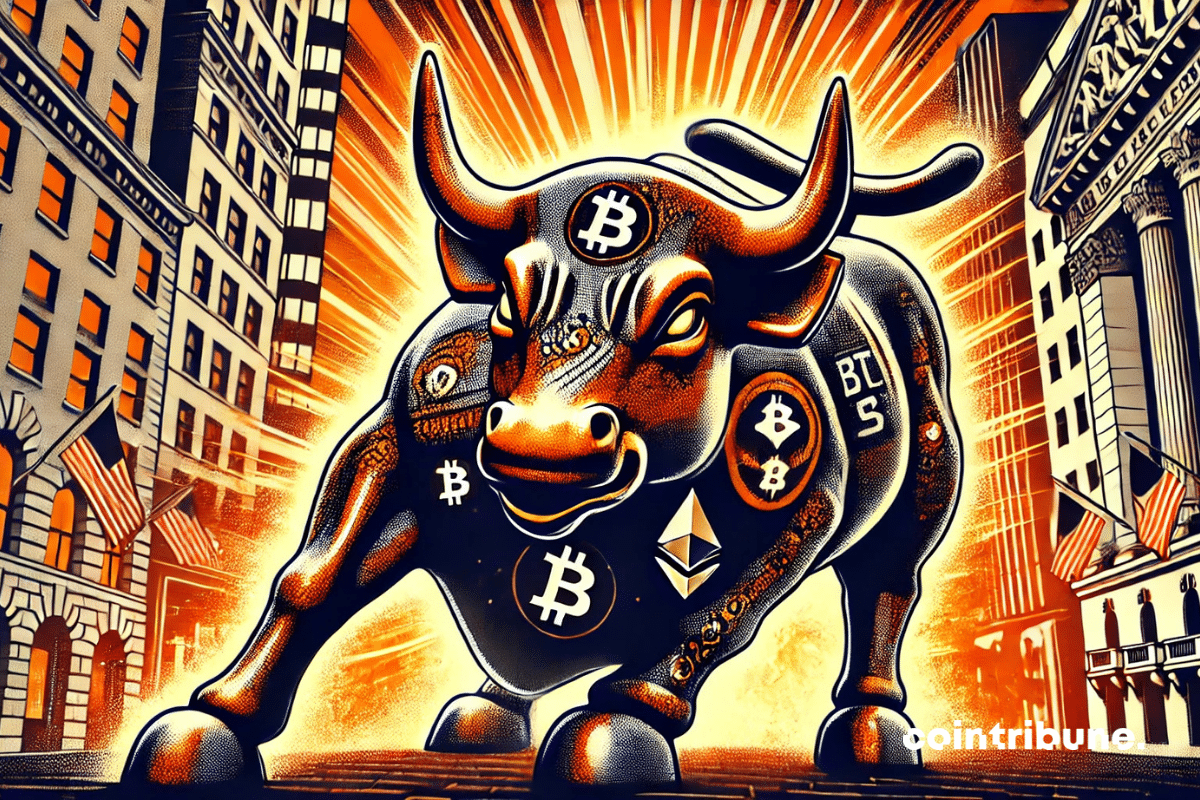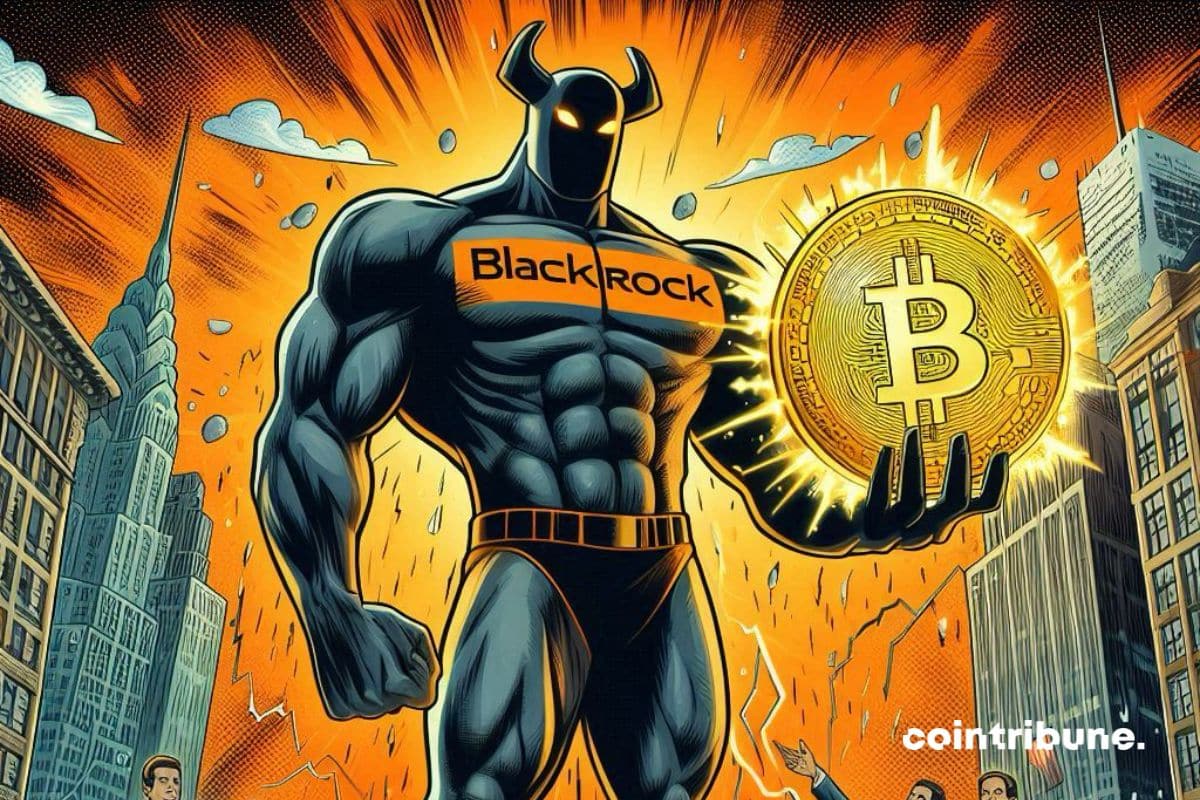The collapse of Shibarium hits Shiba Inu like a thunderclap: 96% fewer transactions, a wreck for the meme crypto, taking with it the hopes of investors.
Short news
Michael Saylor, co-founder of Strategy (formerly MicroStrategy), hinted that his company is set to resume its massive Bitcoin purchases after a brief one-week pause. This announcement comes as Strategy continues its 21/21 plan, aimed at accumulating even more BTC.
In a crazy quest to save the American economy, VanEck sees bitcoin as a miracle cure. Could a strategic reserve of cryptocurrency really wipe out 21 trillion in debt by 2049?
Imagine the scene: Elon Musk, black sunglasses and a MAGA cap firmly on his head, wielding a red chainsaw under the applause of a conservative crowd. Behind him, Javier Milei, Argentine president and figure of ultraliberalism, wears a triumphant smile. On Thursday, February 20, 2025, at the CPAC in Washington, the symbol is violent, almost punk. The chainsaw, gifted by Milei to Musk, embodies much more than a media gadget. It summarizes a declared war against bureaucracy, waged by two iconoclasts determined to redefine the rules of power.
The rise of cryptocurrencies goes beyond speculation and investment. Indeed, the actual use of these assets as a means of payment has reached an unprecedented level, transforming the perception of the sector. Binance Pay, the payment tool of the giant Binance, has just recorded $72.4 billion in transactions in 2024, a figure that reflects increasing adoption. This surge can be attributed in particular to the important role of stablecoins and a diversification of uses, in a context where traditional players struggle to keep pace. While crypto payments were still marginal a few years ago, Binance Pay is now establishing itself as a key player in this revolution.
The crypto market is often unpredictable, but this time, some investors are looking not at technical charts, but at the sky. Indeed, on February 28, a rare alignment of seven planets (Mars, Jupiter, Saturn, Venus, Uranus, Mercury, and Neptune) is drawing the attention of astrologers and the crypto community. According to several experts in financial astrology, this cosmic configuration could signify strong turbulence for Bitcoin and the entire market. Between skepticism and mystical beliefs, the idea that the stars could dictate price movements is divisive, but one thing is certain: the climate of uncertainty is settling in.
The Solana ecosystem is currently going through a period of turbulence due to the increase in scams related to memecoins. The drop in capital flows and the 40% decrease in active users reflect a loss of confidence among investors. However, this crisis could cleanse the market and strengthen the network's credibility.
Warren Buffett is not a man who speaks into the void. When he speaks, the financial world listens. At 94 years old, the legendary investor uses his annual letter to shareholders to deliver a blunt message to Washington: budgetary excesses and monetary instability threaten the American economy. This alarm signal comes at a time when Berkshire Hathaway is recording spectacular financial performances, with a record profit and a historic cash reserve of $334.2 billion. Thus, in a market where investment opportunities are becoming scarce, Buffett favors caution and is preparing to hand over to his designated successor, Greg Abel.
Financial markets are full of analogies and historical models that analysts scrutinize closely to anticipate trends. In the crypto universe, the history of Bitcoin often serves as a compass for understanding the evolution of other major assets. Today, Ethereum seems to be following in the footsteps of BTC, replicating the patterns of its third cycle. This parallel fuels speculation: if history repeats itself, ETH could soon cross a decisive threshold.
Like a magician playing with billions, Lazarus Group makes money from crypto exchanges disappear. Bybit and Phemex? The same sleight of hand, discovered too late.
The idea of an income tax has long been a pillar of the tax policy in the United States. However, Donald Trump intends to challenge this model and proposes to completely replace it with an import tax system. A study conducted by Dancing Numbers claims that this project could generate significant savings for Americans, amounting to $134,809 per individual, and up to $325,561 by eliminating other levies on labor income. But this proposal, if it were to materialize, would not be without consequences for both consumers and the overall economy. Between the promise of increased purchasing power and the risks of trade tensions, this tax reform is already a subject of debate.
The CEO of Bybit, Ben Zhou, has recently taken a strong stance against Pi Network ($PI), stating that it is a scam and that his exchange will never list a fraudulent project. This statement follows a controversy triggered by a Pi Network page, which claimed that Bybit was losing its influence in the crypto market after Pi Network allegedly refused to be listed on the exchange.
The crypto industry has just experienced a strategic twist. Franklin Templeton, a giant in asset management, is launching its Bitcoin & Ether ETF (EZPZ), a bold move that redefines access to cryptocurrencies. Far from being a mere financial product, this ETF embodies a subtle break between the era of individual speculation and that of structured institutional adoption.
BlackRock's Bitcoin ETF now dominates the market with over 50% of assets under management, solidifying its leadership position among ETF issuers in the United States. This dynamic comes as Bitcoin ETFs experience three consecutive days of withdrawals, testing the resilience of BTC.
Binance's BNB Chain blockchain is set to deploy a major update in mid-March 2025, called "Pascal", which will introduce native smart contract wallets. This technical evolution aims to enhance its compatibility with Ethereum and optimize transaction management.
In an already geopolitically tense context marked by increasing economic tensions, Donald Trump has rekindled trade hostilities and is once again targeting the BRICS. The American president called the economic alliance "dead" and threatened to hit its members with a 100% tax on their exports to the United States if they continued to challenge the supremacy of the dollar. This statement immediately provoked a diplomatic reaction from China, which condemned a destructive protectionism and affirmed its commitment to strengthening cooperation among emerging economies.
The crypto subsidiary of Société Générale is continuing its multichain expansion with the deployment of its euro stablecoin EURCV on the Stellar network. This strategic initiative, announced last Thursday, is part of a broader approach aimed at strengthening the bridges between traditional finance and the world of cryptocurrencies.
The security of exchange platforms is a central issue in the crypto universe. A new attack has highlighted the increased vulnerability of the sector: Bybit, one of the most influential exchanges, suffered an exceptionally large hack, with an estimated loss of 1.5 billion dollars in Ethereum. The incident sheds light on the complexity of attacks targeting crypto infrastructures, as well as the challenges platforms face in protecting their users' funds. According to initial investigations, the attack is attributed to the Lazarus group, a cybercriminal organization affiliated with North Korea, already responsible for several massive hijackings in the sector. Bybit claims it can cover the losses, but the event raises questions about the resilience of exchanges in the face of growing threats.
The former CEO of FTX, sentenced to 25 years in prison for massive fraud, is attempting a bold approach to regain his freedom. His parents are actively campaigning with the Republican camp to obtain a presidential pardon from Donald Trump.
On February 21, 2025, the crypto exchange platform Bybit fell victim to an unprecedented hacking incident, resulting in the loss of over 1.4 billion dollars in digital assets. This incident marks the largest theft in the history of cryptocurrencies, far surpassing previous major hacks.
Financial markets do not only react to numbers but also to the feelings and expectations of investors. In the crypto universe, where volatility is the norm, every signal emitted by a major institution can influence trends. This time, it is JPMorgan that makes a splash: the American bank believes that the Bitcoin and Ethereum markets are facing an increased bearish risk due to a disengagement of institutional investors. Such an analysis is based on the evolution of CME futures contracts, which show signs of critical weakness.
The American economy is facing a dynamic that could disrupt the existing balances: demand for long-term Treasury bonds is weakening, calling into question the strength of the dollar and fueling new economic uncertainties. As the Federal Reserve remains committed to a delicate monetary policy and inflation struggles to slow down, Bitcoin finds itself at a strategic crossroads. Historically viewed as a speculative asset, it is now seeing its status evolve as some U.S. states consider incorporating it into their reserves. The central question is thus: will Bitcoin suffer the effects of this uncertainty or will it seize the opportunity to assert itself as an alternative safe haven?
Bitcoin continues its spectacular rise in early 2025, reaching $98,404 on major exchange platforms. This increase comes against a backdrop of growing institutional adoption and promising technical signals, as traditional markets like gold and the S&P 500 also set new records.
On February 21, 2025, Bybit, one of the leading cryptocurrency exchange platforms, revealed that it had fallen victim to a sophisticated cyberattack. According to an official statement, a cold wallet holding Ethereum (ETH) was compromised, allowing an attacker to transfer $560 million to an unidentified hot wallet. This incident highlights the security challenges faced by exchanges in the crypto universe.
A recent survey conducted by Independent Reserve reveals that only one third of Australians consider Donald Trump a positive figure for the cryptocurrency sector, despite the significant rise in Bitcoin since his election. This study comes at a time when Trump’s pro-crypto promises are reshaping the American digital landscape.
A model employee? Rather an illusion. Behind her Excel files, Ho Kai Xin embezzled 5.7 million in crypto. The Singaporean justice system offers her a 10-year stay behind bars.
Michael Saylor proposes a bold vision: the United States should acquire 20% of the circulating bitcoins. In a speech at CPAC, he stated that such a strategy could not only strengthen the dollar but also help pay off the national debt. Behind this financial ambition lies a geopolitical struggle where every major power seeks to assert itself in the digital economy of tomorrow.
Pi Network set to revolutionize crypto? The numbers are skyrocketing and experts are in a frenzy! All the details in this article.
Public financial management is a sensitive topic, especially when it is championed by a polarizing figure like Elon Musk. Since his appointment at the head of the Department of Government Efficiency (DOGE), the entrepreneur has promised a drastic reduction in federal spending to avoid a "bankruptcy of the United States." He announced that he has saved 8 billion dollars by canceling a government contract. A spectacular figure, but quickly contested by several media outlets: the contract in question was actually worth only 8 million dollars.
The SEC, once a bastion of conservatism, is finally awakening to the enchanting song of cryptocurrencies. ETFs are making a grand entrance, and the agency, once inflexible, seems to be discovering the virtues of compromise.





























